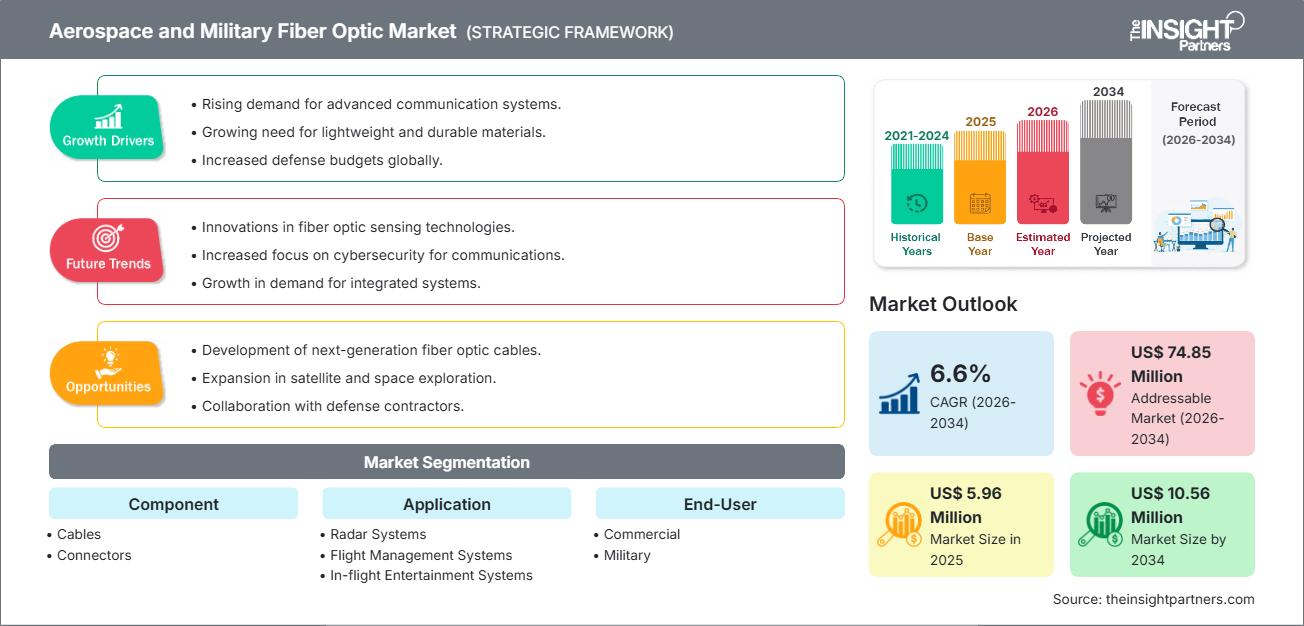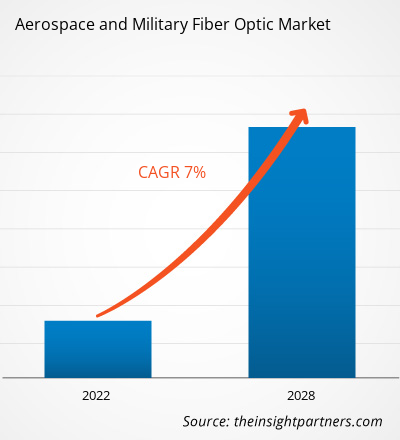航空宇宙および軍事用光ファイバー市場の規模は、2025年の596万米ドルから2034年には1,056万米ドルに達すると予想されています。市場は2026年から2034年の間に6.6%のCAGRを記録すると予想されています。
航空宇宙および軍事用光ファイバー市場分析
市場予測は、主に現代の防衛・航空宇宙プラットフォームにおける安全で高速、かつ低遅延なデータ伝送の必要性に牽引され、堅調な成長を示しています。市場拡大は、航空機や無人航空機(UAV)の軽量化が急務となっていることで加速しており、燃費向上と積載量増加のため、重量のある銅線ケーブルに代わる軽量光ファイバーケーブルが求められています。さらに、大規模な防衛近代化計画や、航空電子機器および電子戦システムの複雑化の進行により、高度で耐久性の高い光ファイバー部品の需要が高まっています。
航空宇宙および軍事用光ファイバー市場の概要
光ファイバー技術は、射出成形システムにおいて極めて重要な役割を果たし、複数のゾーンにわたって均一な加熱を実現し、最適なメルトフローを維持します。軍事および航空宇宙用途において、光ファイバーは、従来の銅線に比べて優れたデータスループット、電磁干渉(EMI)耐性、そして強化されたセキュリティを備えているため、不可欠です。これらのシステムは、C4ISR(指揮統制、通信、コンピューター、情報収集、監視、偵察)、レーダー、飛行管理システムといったミッションクリティカルな用途に不可欠なコンポーネントです。過酷な環境にも耐えうる信頼性の高いデータリンクを提供することで、光ファイバーは民間および軍事プラットフォームの両方において、高精度な運用と安全なデータ転送の基盤となっています。
要件に合わせてレポートをカスタマイズ
このレポートの一部、国レベルの分析、Excelデータパックなど、あらゆるレポートを無料でカスタマイズできます。また、スタートアップや大学向けのお得なオファーや割引もご利用いただけます。
航空宇宙および軍事用光ファイバー市場:戦略的洞察

-
このレポートの主要な市場動向を入手してください。この無料サンプルには、市場動向から見積もりや予測に至るまでのデータ分析が含まれます。
航空宇宙および軍事用光ファイバー市場の推進要因と機会
市場の推進要因:
- 高速データと帯域幅の需要の増加: 現代の軍事および商用プラットフォーム (第 5 世代戦闘機、衛星など) では、複雑なセンサー アレイからのデータ融合とリアルタイム処理をサポートするために、超高帯域幅が必要です。
- システム重量削減の必要性: 光ファイバー ケーブルにより、機内配線ハーネスの重量が大幅に軽減され、航空機の燃料効率と積載能力が直接的に向上します。
- 電磁干渉 (EMI) に対する耐性: 光ファイバーは電気信号の代わりに光を送信し、EMI に対する固有の耐性を提供します。これは、レーダーや電子戦装置の近くのシステムや EMP 攻撃に対する耐性にとって重要です。
- 防衛の近代化と新型航空機の調達: 世界的な防衛予算と、先進的な航空電子機器を活用した新型商用航空機の注文増加により、光ファイバー システムの統合が推進されています。
市場機会:
- 自律システム (UAV/UGV) の普及: 無人システムは、リモート制御、センサー フィードバック、協調ミッションのために、低遅延の高速光ファイバー リンクに大きく依存しています。
- 高度な光ファイバー センサーの統合: 精密ナビゲーション用の光ファイバー ジャイロスコープ (FOG) と境界セキュリティ用の分散音響センシング (DAS) の採用により、大きな成長の可能性が生まれます。
- 量子セキュア通信の開発: 量子鍵配布 (QKD) に光ファイバー回線を使用すると、事実上解読不可能な暗号化が可能になり、重要な軍事通信ネットワークに価値の高い機会が生まれます。
- 小型化と耐久性向上: 小型で耐久性に優れた高密度のコネクタとケーブルの継続的な革新により、限られた厳しい軍事/宇宙環境でのアプリケーション範囲が拡大します。
航空宇宙および軍事用光ファイバー市場レポートのセグメンテーション分析
航空宇宙・軍事用光ファイバー市場のシェアは、様々なセグメントにわたって分析され、その構造、成長の可能性、そして新たなトレンドをより明確に理解することができます。以下は、ほとんどの業界レポートで使用されている標準的なセグメンテーション手法です。
コンポーネント別:
- ケーブル
- コネクタ:
コンポーネントセグメントは、高速かつ安全なデータパスウェイへの切実なニーズに牽引され、市場の基盤を形成しています。ケーブルは、用途に応じてシングルモードまたはマルチモードが一般的で、過酷な環境ストレスに耐えられるように設計されています。また、拡張ビーム型やハーメチック型のコネクタは、航空宇宙および防衛分野のミッションクリティカルなシステムに、信頼性が高く低損失の相互接続を提供するために使用されています。
用途別:
- レーダーシステム
- 飛行管理システム
- 機内エンターテイメントシステム
- 通信システム
- 電子戦
- キャビンインテリア
- 航空電子機器。
アプリケーションセグメントは市場需要を定義する上で非常に重要です。航空・陸・海上のプラットフォームにおける信頼性の高い高帯域幅通信の需要により、リアルタイムのC4ISR(集中監視・情報監視)と高度なナビゲーションをサポートする通信システムが最大のシェアを占め、これに続いてアビオニクスが続いています。
エンドユーザー別:
- 商業航空宇宙: 光ファイバーにより、最新の機内エンターテイメントと高度な飛行管理システムが実現され、航空機の総重量が軽減されるとともに、高度な乗客通信サービスがサポートされます。
- 軍事および防衛: 最大のエンドユーザーであり、電磁気の脅威の影響を受けない戦術的通信、ミサイル誘導、電子戦 (EW) システム用の高信頼性で耐久性の高いファイバーを要求しています。
地理別:
- 北米
- ヨーロッパ
- アジア太平洋
- 南米と中央アメリカ
- 中東・アフリカ
アジア太平洋地域の航空宇宙および軍事用光ファイバー市場は、中国やインドなどの国々における急速な防衛近代化と大規模な商用航空機群の拡大により、予測期間中に最も急速な成長が見込まれています。
航空宇宙および軍事用光ファイバー市場の地域別分析
予測期間全体を通して航空宇宙・軍事用光ファイバー市場に影響を与える地域的なトレンドと要因については、The Insight Partnersのアナリストが詳細に解説しています。本セクションでは、北米、ヨーロッパ、アジア太平洋、中東・アフリカ、中南米における航空宇宙・軍事用光ファイバー市場のセグメントと地域についても解説します。
航空宇宙および軍事用光ファイバー市場レポートの範囲
| レポート属性 | 詳細 |
|---|---|
| 2025年の市場規模 | 596万米ドル |
| 2034年までの市場規模 | 1,056万米ドル |
| 世界のCAGR(2026年~2034年) | 6.6% |
| 履歴データ | 2021-2024 |
| 予測期間 | 2026~2034年 |
| 対象セグメント |
コンポーネント別
|
| 対象地域と国 |
北米
|
| 市場リーダーと主要企業の概要 |
|
航空宇宙および軍事光ファイバー市場のプレーヤー密度:ビジネスダイナミクスへの影響を理解する
航空宇宙・軍事用光ファイバー市場は、消費者嗜好の変化、技術の進歩、製品メリットへの認知度の向上といった要因によるエンドユーザー需要の増加に牽引され、急速に成長しています。需要の増加に伴い、企業は製品ラインナップの拡充、消費者ニーズへの対応のためのイノベーション、そして新たなトレンドの活用を進めており、これが市場の成長をさらに加速させています。

- 航空宇宙および軍事光ファイバー市場のトップキープレーヤーの概要を入手
航空宇宙および軍事用光ファイバー市場シェアの地域別分析
アジア太平洋地域は今後数年間で最も急速に成長すると予想されています。南米、中米、中東、アフリカの新興市場にも、光ファイバーシステムプロバイダーにとって事業拡大の未開拓の機会が数多く存在します。
航空宇宙・軍事用光ファイバー市場は、防衛費、航空機の近代化サイクル、厳格な規制環境といった要因により、地域ごとに異なる成長軌道を示しています。以下は、地域別の市場シェアとトレンドの概要です。
-
北米
- 市場シェア: 高度な防衛製造と広範な研究開発投資により、圧倒的な市場シェアを維持しています。
-
主な推進要因:
- 先進的なプラットフォーム(F-35、UAVなど)におけるファイバーの広範な採用
- 軍のC4ISRと監視に多額の予算を割り当てる
- 主要な航空宇宙OEMの存在
- トレンド: 宇宙および衛星通信用の高密度で放射線耐性のあるファイバーへの移行、超安全な軍事リンク用の量子鍵配布 (QKD) への重点。
-
ヨーロッパ
- 市場シェア: 主要な防衛プログラムとシステム安全性に関する規制要件によって推進され、強力な市場プレゼンスを確立しています。
-
主な推進要因:
- 材料規格(例:REACH、RoHS)の厳格な遵守
- 将来戦闘航空システム(FCAS)などの主要な防衛構想
- 光ファイバージャイロスコープ(FOG)の需要の高まり
- トレンド: 次世代の戦闘機と海軍艦艇の小型化と軽量化への重点化が進み、艦載レーダーや EW システムへのファイバーの採用が拡大しています。
-
アジア太平洋
- 市場シェア: 急速な防衛近代化と商用艦隊の急増により、最も急速に成長している地域。
-
主な推進要因:
- 政府支援による国産防衛生産プログラム
- 中国とインドからの大量の商用航空機の受注
- 海軍および海上監視への投資の増加
- 傾向: コスト効率に優れた高出力通信システム向けマルチモードおよびシングルモード ケーブルの採用が拡大、地域の需要を満たす現地製造能力の開発。
-
南米と中央アメリカ
- 市場シェア: 国防強化への投資が拡大している新興市場。
-
主な推進要因:
- 現地の航空宇宙製造能力の拡大(例:ブラジル)
- 老朽化する航空機群における効率的な航空電子機器ソリューションの必要性。
- 防衛技術移転のための官民パートナーシップ
- トレンド: 地上通信ネットワーク用の耐久性の高い戦術的ファイバーの採用が増加。防衛用途向けのコスト効率が高く耐久性のあるファイバー ソリューションに重点が置かれる。
-
中東およびアフリカ
- 市場シェア: 防衛および航空宇宙インフラ支出の増加により、大きな成長の可能性を秘めた発展途上市場。
-
主な推進要因:
- 国防多様化プロジェクト(例:サウジアラビア、UAE)
- 軍事および航空交通への投資を促進する戦略的な地理的位置
- 国境と重要なインフラのセキュリティの必要性。
- トレンド: 境界セキュリティのためのファイバーベースの分散音響センシング (DAS) の実装、安全な高帯域幅のバックボーンを必要とする統合監視および C4ISR システムへの投資。
航空宇宙および軍事光ファイバー市場のプレーヤー密度:ビジネスダイナミクスへの影響を理解する
高い市場密度と競争
Carlisle Interconnect Technologies、Amphenol Corporation、TE Connectivityといった大手グローバルベンダーの存在により、競争は激化しています。また、地域に特化した専門企業やニッチな光ファイバー技術企業も市場環境に貢献しています。
この競争環境により、ベンダーは次のような差別化を迫られています。
- 技術的リーダーシップ: 厳格な業界標準 (F-35 プログラムなど) を満たす小型化、耐放射線化 (宇宙用)、超軽量ソリューションの研究開発に重点を置いています。
- 製品の耐久性向上: 極端な機械的衝撃、振動、温度変化下でも確実に動作できる、耐久性に優れたケーブル アセンブリとコネクタ (拡張ビーム コネクタなど) を開発します。
- 戦略的パートナーシップ: 大手防衛請負業者や軍事機関と連携し、次世代の光学ソリューションを長期防衛プログラム (例: 将来の戦闘航空システム) に統合します。
- システム統合: 航空機および防衛プラットフォームメーカーの設置の複雑さを軽減し、市場投入までの時間を短縮する、シームレスで事前に終端されたファイバー ハーネスと接続ソリューションを提供します。
航空宇宙および軍事用光ファイバー市場で事業を展開している主要企業は次のとおりです。
- カーライル・インターコネクト・テクノロジーズ
- アンフェノールコーポレーション
- レイセオン・テクノロジーズ・コーポレーション
- プリスミアングループ
- ITT株式会社
- TEコネクティビティ
- AFLコーポレーション
- ティンバーコン株式会社
- ネクサンスグループ
免責事項:上記の企業は、特定の順序でランク付けされているわけではありません。
航空宇宙および軍事用光ファイバー市場のニュースと最近の動向
- アンフェノールによるカーライル・インターコネクト・テクノロジーズの買収:航空宇宙・防衛分野における過酷環境向け相互接続ソリューションのリーディングサプライヤーであるカーライル・インターコネクト・テクノロジーズ(CIT)は、アンフェノール・コーポレーションとの買収契約を約20億2,500万ドルで締結したことを発表しました。この買収契約は2024年第2四半期に完了予定で、これによりアンフェノールの商用および軍事プラットフォームにおける光ファイバー技術が強化されます。
- アンフェノール、高耐久性光ファイバートランシーバを発表:アンフェノール・アクティブ・オプティクスは、SCFF 1-TRX 10G/25GやFiberQuadなど、航空宇宙・防衛分野の過酷な用途向けに、高速高耐久性トランシーバシリーズを発表しました。これらのソリューションは、チャネルあたり最大28Gbpsのデータレートを実現し、高度なレーダーおよび航空電子機器システムをサポートします。
- レイセオン テクノロジーズが量子センサーに関する DARPA 契約を獲得 : レイセオンの BBN テクノロジーズは、スクイーズド光を使用したフォトニック チップ スケールの量子センサーの開発で DARPA 賞を受賞しました。このセンサーは、軍事用途のファイバー ベースのセンシングおよびナビゲーション システムの感度を 10 倍向上させると期待されています。
航空宇宙および軍事用光ファイバー市場レポートの対象範囲と成果物
「航空宇宙および軍事用光ファイバー市場の規模と予測(2021〜2034年)」レポートでは、以下の分野を網羅した市場の詳細な分析を提供しています。
- 航空宇宙および軍事用光ファイバー市場の規模と予測。コンポーネント、アプリケーション、エンドユーザー、プラットフォームタイプなど、調査範囲に含まれるすべての主要な市場セグメントについて、世界、地域、国レベルでの予測です。
- 航空宇宙および軍事用光ファイバー市場のトレンド、および業界の成長に影響を与える推進要因、制約要因、主要な機会などの市場動向。主な要因としては、高速かつ安全なデータ伝送、軽量システム設計、軍事および航空宇宙機の近代化に対する需要の高まりなどが挙げられます。
- 詳細な PEST および SWOT 分析により、市場の状況を形成する政治的、経済的、社会的、技術的な力についての洞察が得られます。
- 航空宇宙および軍事用光ファイバー市場の分析では、主要な市場動向、世界および地域のフレームワーク、主要プレーヤー、防衛調達基準、航空宇宙および軍事通信ネットワーク全体の最近の技術開発を網羅しています。
- 航空宇宙および軍事用光ファイバー市場における市場集中、ヒートマップ分析、主要プレーヤー、戦略的開発を網羅した業界の展望と競争分析。
- Amphenol Corporation、TE Connectivity、Carlisle Interconnect Technologies、Raytheon Technologies Corporation、Corning Incorporated などの大手企業の詳細な会社プロファイル。事業概要、製品ポートフォリオ、最近の契約、パートナーシップ、財務ハイライト (利用可能な場合) などが含まれます。
- 過去2年間の分析、基準年、CAGRによる予測(7年間)
- PEST分析とSWOT分析
- 市場規模価値/数量 - 世界、地域、国
- 業界と競争環境
- Excel データセット
最新レポート
お客様の声
購入理由
- 情報に基づいた意思決定
- 市場動向の理解
- 競合分析
- 顧客インサイト
- 市場予測
- リスク軽減
- 戦略計画
- 投資の正当性
- 新興市場の特定
- マーケティング戦略の強化
- 業務効率の向上
- 規制動向への対応






















 無料サンプルを入手 - 航空宇宙および軍事用光ファイバー市場
無料サンプルを入手 - 航空宇宙および軍事用光ファイバー市場